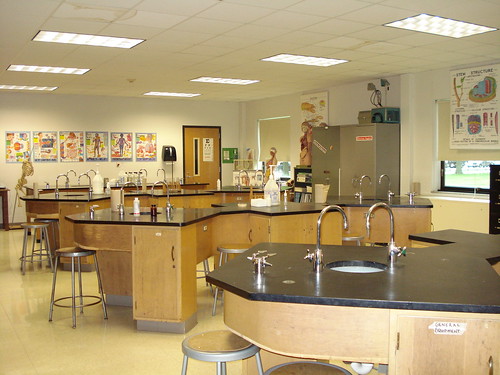"Distractions" in the classroom
By Mary Bigelow
Posted on 2011-06-01
 I’m having some classroom management problems in my middle school science classes. I think the classroom itself provides many distractions and contributes to the problem. My middle-school students sit at lab tables, facing each other. Their chairs spin, they are able to open the drawers and put trash in, they can turn on the sinks, and they can stuff things down the drain. How can I train these kids to sit in a chair and not play with the sinks or cabinets?
I’m having some classroom management problems in my middle school science classes. I think the classroom itself provides many distractions and contributes to the problem. My middle-school students sit at lab tables, facing each other. Their chairs spin, they are able to open the drawers and put trash in, they can turn on the sinks, and they can stuff things down the drain. How can I train these kids to sit in a chair and not play with the sinks or cabinets?
—Anne, Postville, Iowa
You might be on to something about the relationship between student behavior and their environment. I taught in a similar situation—seventh grade students sitting at lab tables of four, facing each other. I actually liked this arrangement, because I did a lot of collaborative work and the students didn’t need to move around to work with a partner or in lab groups.
However, I noticed about middle schoolers (more so than high school) all have the fidgets. It’s hard for them to stay still for long periods of time, especially by the end of the day. Expecting these students (or anyone else for that matter) to sit still for long periods of time is unrealistic.
The key is to channel their energy and remove temptations for disruptive or destructive behavior (as you’re thinking). Are there valves at the tables to turn off the water (like on a sink at home)or a master valve for the room? If so, turn off the water except on days it’s necessary. To keep kids from putting trash in the sink, cover the sink with a small board. Attach the cover to the table with a fabric hook-and-loop fastener, so that it can be removed for labs (and you’ll hear the skritch sound if a student tries to remove it!). This obviously works only if the water is turned off. It also provides a bit more room on the table for students to work.
Can you trade in the swivel stools for rigid ones (or adjust something underneath to keep them from revolving)? The students will still rock on them, but at least they won’t be making you dizzy. Your bulletin boards should have items related to the unit, so when students are looking at them, they’ll still be focused on science.
My colleague did not use the drawers in his lab tables and they were not lockable. So he took the handles off. He made a wire tool so that he could open them, and he stored old textbooks in them to make them heavy to pry open. And if the tables have electrical outlets—can you turn the electricity off via the circuit breaker? Or at least cover them with outlet covers. (I learned this after a student inserted a pair of forceps into the outlet with “shocking” results—I still see him around town and we can now smile about it 20 years later).
You’ll still need some ways to channel their energy, varying the activities during class: cooperative learning, think-pair-share, bellringers, hands-on activities, notebooks, working at the smartboard, stand-and-stretch breaks. As you introduce an activity, model what it should look (and sound) like. When students are working individually or in teams, walk around the room, patrolling the perimeter to answer questions or provide support. Use an empty table in the back of the room or a desk or two along the side for students who need a time-out from their groups or from the stools or who want to be closer to the front during large group discussions. Establish routines for transitions between events. I used to chant “one, two, three, look at me” to get their attention and re-focus on the front of the room. Sounds silly, but middle schoolers would clap during the “one, two, three” part.
Be sure to differentiate between disruptive or destructive behaviors and those that are simply annoying. For example, I had a student who would unconsciously tap her pencil while she was thinking. Rather than making an issue out of this, I gave her a mouse pad to deaden the sound. Another student found it hard to sit at the end of the day, so I encouraged him to stand in the back of the room instead of rocking on the stool.
But whatever you decide to do, don’t make your classroom environment sterile, joyless, and regimented. Your science classroom should be a stimulating place where you and your students can focus on activities to explore and learn.
Photo: http://www.flickr.com/photos/40964293@N07/4018106328/
Disclaimer: The views expressed in this blog post are those of the author(s) and do not necessarily reflect the official position of the National Science Teaching Association (NSTA).


